Amistad Fortalecida por Pasar Tiempo al Aire Libre
Estaba oscuro y frío cuando la alarma de nuestro teléfono sonó a las 4 am. Empacamos la carpa y...
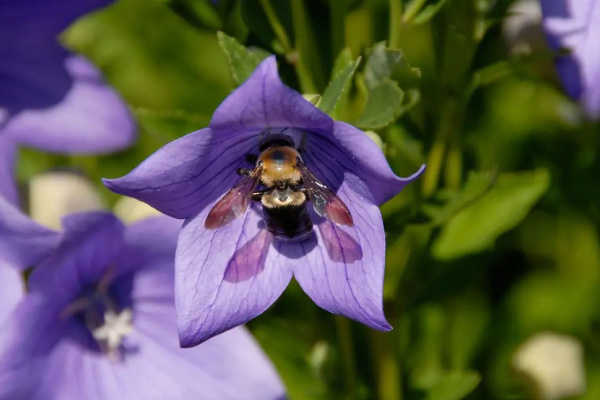
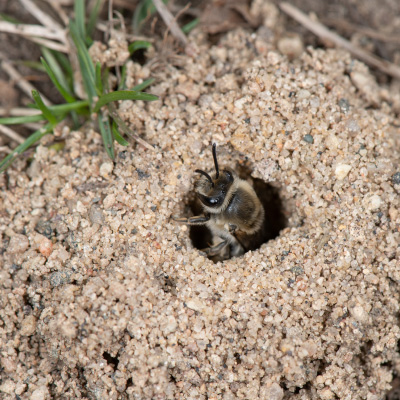 Hay pocos símbolos en la naturaleza más poderosos que la flor y la abeja. Las flores gotean con dulce néctar para atraer a todo tipo de polinizadores hambrientos, desde moscas hasta colibríes, quienes a su vez esparcen el polen necesario para que las plantas se reproduzcan. América del Norte es el hogar de miles de estos insectos, aves y otros organismos polinizadores; pero ninguno ha encontrado un lugar en nuestra sociedad como la abeja europea. Aunque sólo en los EE. UU. Desde el siglo XVII; Estas abejas han tenido sus colonias movidas, estudiadas y trabajadas por humanos durante más de 5,000 años. Hoy en día, gran parte de nuestra agricultura depende de las colonias de abejas mantenidas por apicultores. Desde granjas de cientos de acres hasta el jardín en su patio trasero, las abejas se han convertido en nuestros socios en la batalla en curso por la seguridad alimentaria y la preservación del medio ambiente.
Hay pocos símbolos en la naturaleza más poderosos que la flor y la abeja. Las flores gotean con dulce néctar para atraer a todo tipo de polinizadores hambrientos, desde moscas hasta colibríes, quienes a su vez esparcen el polen necesario para que las plantas se reproduzcan. América del Norte es el hogar de miles de estos insectos, aves y otros organismos polinizadores; pero ninguno ha encontrado un lugar en nuestra sociedad como la abeja europea. Aunque sólo en los EE. UU. Desde el siglo XVII; Estas abejas han tenido sus colonias movidas, estudiadas y trabajadas por humanos durante más de 5,000 años. Hoy en día, gran parte de nuestra agricultura depende de las colonias de abejas mantenidas por apicultores. Desde granjas de cientos de acres hasta el jardín en su patio trasero, las abejas se han convertido en nuestros socios en la batalla en curso por la seguridad alimentaria y la preservación del medio ambiente.
No todo el mundo puede o debe ser apicultor, pero todos debemos trabajar para proporcionar un hábitat a los polinizadores que han hecho de Colorado su hogar. La abeja europea es solo un ejemplo, pero ¿sabía que nuestro estado alberga más de la mitad de las 46 especies de abejorros? Aunque no producen miel, estas abejas son autóctonas de América del Norte y han evolucionado conjuntamente con nuestras plantas nativas durante miles de años. Los abejorros son más grandes, más peludos y no viajan tan lejos en busca de flores frescas como sus parientes europeos productores de miel. La última de estas diferencias significa que nuestras colonias de abejorros silvestres son especialmente susceptibles a la pérdida de hábitat. Los caminos y las casas son ejemplos obvios de lugares donde se han eliminado las plantas nativas para nuestro beneficio, pero incluso nuestros "espacios verdes" son en gran parte pasto con poca tierra asignada para flores. Estamos viendo que las poblaciones de abejorros disminuyen rápidamente en el este de los Estados Unidos debido a esta expansión urbana. Al ritmo de crecimiento de Colorado, podríamos ser los próximos en poner a nuestras abejas nativas en la tabla de cortar.
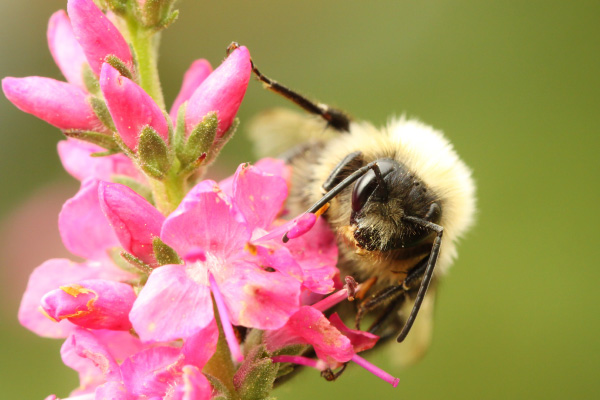 Entonces, ¿qué podemos hacer con la difícil situación de los polinizadores? ¡Nuestra sugerencia principal sería plantar más flores! Sembrar todo el césped sería lo mejor, pero incluso asignar algo de espacio en su tierra a las flores nativas puede marcar una gran diferencia para las abejas, las mariposas y otros insectos. En áreas donde hay pocas flores, los polinizadores terminan compitiendo por los recursos. Las abejas pueden expulsar a nuestros abejorros si no tomamos la iniciativa y les damos tantas fuentes de alimento como sea posible. La diversidad de plantas en un área es tan importante como la cantidad. Cuando piense en qué probar en su jardín, sepa que una variedad más amplia de flores atraerá a una variedad más amplia de polinizadores. Una vez en su propiedad, estos insectos se esparcieron por el jardín y producirán cosechas más saludables y más abundantes. No todas las flores producen frutas y verduras, pero todas las frutas y verduras comienzan como flores que necesitan ser polinizadas.
Entonces, ¿qué podemos hacer con la difícil situación de los polinizadores? ¡Nuestra sugerencia principal sería plantar más flores! Sembrar todo el césped sería lo mejor, pero incluso asignar algo de espacio en su tierra a las flores nativas puede marcar una gran diferencia para las abejas, las mariposas y otros insectos. En áreas donde hay pocas flores, los polinizadores terminan compitiendo por los recursos. Las abejas pueden expulsar a nuestros abejorros si no tomamos la iniciativa y les damos tantas fuentes de alimento como sea posible. La diversidad de plantas en un área es tan importante como la cantidad. Cuando piense en qué probar en su jardín, sepa que una variedad más amplia de flores atraerá a una variedad más amplia de polinizadores. Una vez en su propiedad, estos insectos se esparcieron por el jardín y producirán cosechas más saludables y más abundantes. No todas las flores producen frutas y verduras, pero todas las frutas y verduras comienzan como flores que necesitan ser polinizadas.
El uso extensivo de productos químicos en las plantas puede dificultar el primer paso para la conservación de los polinizadores. Si bien no son tan dañinos para nosotros, las trazas de estos pesticidas y herbicidas pueden ser perjudiciales para el sistema nervioso de insectos como las abejas. Estos productos químicos persisten en el medio ambiente y pueden seguir afectando a nuestros polinizadores meses después de su aplicación. Más allá de la fumigación directa, incluso las plantas y semillas que compramos en la tienda vienen pre-recubiertas con varios pesticidas. Eliminar los productos químicos agresivos de su rutina de cuidado del césped y comprar productos orgánicos es un excelente comienzo a nivel individual, pero no lo suficiente para resolver el problema. Los gobiernos locales a menudo recurren a herbicidas y pesticidas como soluciones baratas para hacer que los espacios públicos se vean mejor y reducir ciertas poblaciones de insectos.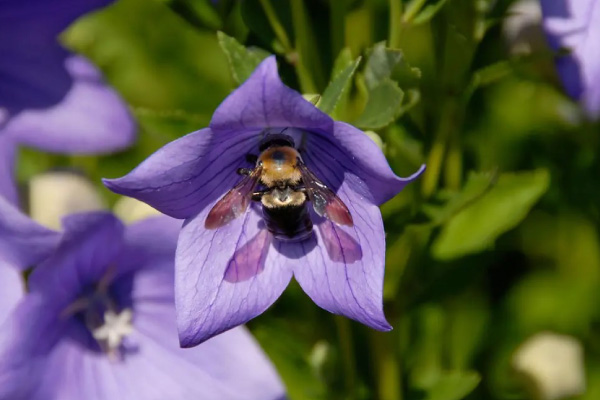
Estos pasos se toman sin pensar en el impacto ambiental, especialmente en nuestros insectos beneficiosos. Como comunidad, es crucial para nosotros unirnos en torno a nuestros polinizadores y protegerlos. Si mostramos a nuestro liderazgo local que las abejas son algo que valoramos, entonces debemos tomar medidas para protegerlas. Puede encontrar más información sobre qué herbicidas y pesticidas específicos usa su localidad en el sitio web de su ciudad.
¡Edúquese, corra la voz y unámonos para salvar a todos los polinizadores!
Recursos:
https://extension.colostate.edu/topic-areas/insects/attracting-native-bees-landscape-5-615/
https://coloradobeekeepers.org/think-you-want-to-keep-bees/where-to-get-bees/
Jake Allread es un cuidador de abejas para Knapp Ranch.
 There are few symbols in nature more powerful than the flower and the bee. Flowers drip with sweet nectar to attract all kinds of hungry pollinators – from flies to hummingbirds – who in turn spread the pollen needed for plants to reproduce. North America is home to thousands of these insects, birds, and other pollinating organisms; but none have found a place in our society like the European Honeybee. While only in the U.S. since the 1600s; these honeybees have had their colonies moved, studied, and worked by humans for over 5,000 years. Today, much of our agriculture is dependent on honeybee colonies maintained by beekeepers. From farms that are hundreds of acres to the garden in your backyard, bees have become our partners in the ongoing battle for both food security and environmental preservation.
There are few symbols in nature more powerful than the flower and the bee. Flowers drip with sweet nectar to attract all kinds of hungry pollinators – from flies to hummingbirds – who in turn spread the pollen needed for plants to reproduce. North America is home to thousands of these insects, birds, and other pollinating organisms; but none have found a place in our society like the European Honeybee. While only in the U.S. since the 1600s; these honeybees have had their colonies moved, studied, and worked by humans for over 5,000 years. Today, much of our agriculture is dependent on honeybee colonies maintained by beekeepers. From farms that are hundreds of acres to the garden in your backyard, bees have become our partners in the ongoing battle for both food security and environmental preservation.
Not everyone can or should be a beekeeper, but all of us must work to provide habitat for the pollinators that have made Colorado their home. The European Honeybee is just one example, but did you know that our state is home to over half of the 46 species of bumblebee? Although they do not make honey, these bees are indigenous to North America and have co-evolved with our native plants for thousands of years. Bumblebees are larger, furrier, and don’t travel as far in search of fresh flowers as their honey-making, European relatives. The last of these differences means our wild bumblebee colonies are especially susceptible to habitat loss. Roads and houses are obvious examples of places where native plants have been removed for our benefit, but even our “green spaces” are largely grass with little land allocated for flowers. We are seeing bumblebee populations decline rapidly in the eastern U.S. due to this urban sprawl. At the rate Colorado is growing, we could be next to put our native bees on the chopping block.
So, what can we do about the plight of the pollinators? Our primary suggestion would be to plant more flowers! Seeding the entire lawn would be best, but even just allocating some space on your land to native flowers can make a huge difference for bees, butterflies, and other insects. In areas where there are few flowers, pollinators end up competing for resources. Honeybees can push out our bumblebees if we do not take the initiative and give them as many food sources as possible. The diversity of plants in an area is just as important as the quantity. When thinking of what to try out in your yard, know that a wider variety of flowers will attract a wider variety of pollinators. Once at your property, these insects will spill over into the garden and lead to healthier, larger harvests! Not all flowers produce fruits and vegetables, but all fruits and vegetables start out as flowers that need to be pollinated.
The extensive use of chemicals on plants can make the first step to pollinator preservation more difficult. While not as harmful to us, trace amounts of these pesticides and herbicides can be detrimental to the nervous systems of insects like bees. These chemicals persist in the environment and can continue affecting our pollinators months after their application. Beyond direct spraying, even the plants and seeds we buy from the store come pre-coated with various pesticides. Removing harsh chemicals from your lawn care routine and buying organic are an excellent start at the individual level, but not enough to solve the problem. Local governments often turn to herbicides and pesticides as cheap solutions to making public spaces look better and reducing certain insect populations.
These steps are taken with little thought of the environmental impact, especially on our beneficial insects. As a community, it is crucial for us to rally around our pollinators and protect them! If we show our local leadership that bees are something we value, then they must take steps to protect them. You can find more information about what specific herbicides and pesticides your locality is using at your town’s website.
Educate yourself, spread the word, and let’s unite to save all pollinators!
Resources:
https://extension.colostate.edu/topic-areas/insects/attracting-native-bees-landscape-5-615/
https://coloradobeekeepers.org/think-you-want-to-keep-bees/where-to-get-bees/
Jake Allread is the Beekeper at Knapp Ranch.
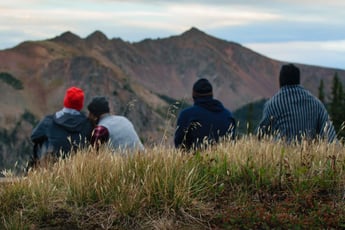
Estaba oscuro y frío cuando la alarma de nuestro teléfono sonó a las 4 am. Empacamos la carpa y...
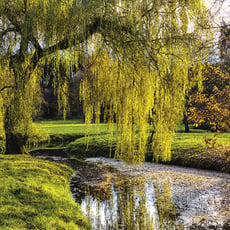
Una historia clásica de la exploración occidental temprana comienza en una espesura de sauces. Un...